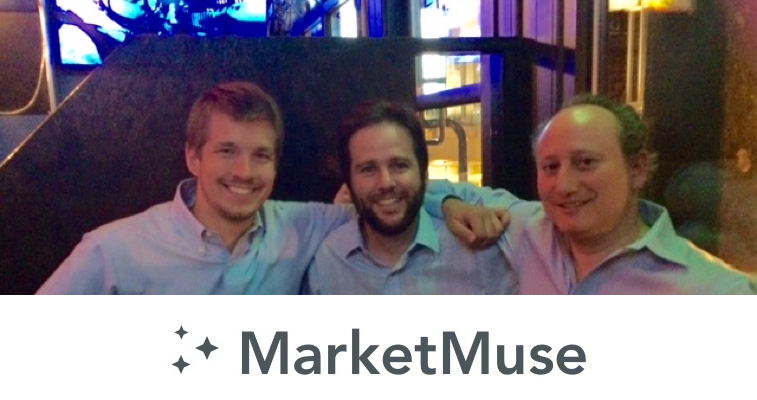Several companies offer content marketers tools to determine keyword search volumes. However, it still leaves them with two very important questions to answer: what should I write about and how should I write about it?
Those are the questions MarketMuse aims to answer.
MarketMuse helps companies improve their inbound marketing by using big data and artificial intelligence to understand the way search engines evaluate content. The company uses that information to guide customers through optimized content strategies.
“The problem is that content is really hard to execute,” MarketMuse Founder and Chief Product Officer Aki Balogh says. “I figured it would be great if there was a way to help people using artificial intelligence or machine learning. That’s what we do.”
MarketMuse starts by analyzing a customer’s website to determine what the business is about. From there, it downloads tens of thousands of pieces of high-quality semantic content and uses machine learning to create collections of topics related to that subject. The collections, which MarketMuse refers to as topic clusters, are used to give advice on ranking for that subject.

“We crunch all that data and basically compare what your site is about to what it should be about,” Balogh says. “If a customer wants to write about a particular topic, we give them the important concepts, keywords and a searcher intents.”
MarketMuse has customers of all sizes and can serve both B2B and B2C clients. The B2B tech sector is MarketMuse’s biggest focus, followed by the financial services, consumer goods and healthcare sectors.
Smaller businesses use the software directly while MarketMuse delivers content plans, editorial briefs and other strategic advice to its larger customers.
MarketMuse has positioned itself nicely as a complement to other content platforms like HubSpot, Marketo and Pardot, but finding its niche was anything but easy.
Balogh’s background is in data analytics. In 2011, he gained experience using datasets to help businesses as an associate at OpenView Venture Partners.
“Using data science comes down to three pieces: algorithms, data and a business problem,” Balogh explains. “You need all three to create a great data science solutions and I’m always looking at all three."
After nine months at OpenView, Balogh worked in sales and marketing at InfiniDB, an early-stage startup that built a high-performance analytic database.
During that time Balogh started doing extensive research into what it takes to develop an online presence and drive inbound sales. If Balogh’s findings had to be boiled down into a single mantra, it might be ‘Don’t fight Google.'
“The SEO industry got a bad rep over the years because people got distracted gaming the system with keyword stuffing and things like that,” Balogh says. “With every update, Google stamps that stuff out.”
“What we’re saying is don’t overthink it, just write great content. That’s what SEO is moving toward now. If you write quality content in an informative and authoritative way you’ll do well in organic searches.”
That concept might sound boring to content marketers looking for Google’s secret sauce, but it’s worth noting that it’s coming from a person who makes a living analyzing data from millions of pages of search results.
Nowadays, MarketMuse’s complex service works so seamlessly it’s hard to imagine the grueling development process that took place in the company’s early stages.
Balogh knew he wanted to help marketers write great content, but he needed help figuring out which technologies made sense for a solution.
During an event in 2013, Balogh met artificial intelligence technologist Richard Mallah. Mallah formerly worked at Cambridge Semantics Inc., and also serves as Director of AI Projects at the Future of Life Institute, a non-profit dedicated to making emerging AI technologies beneficial to humanity.
“Richard sort of explained what is possible with new technologies and helped me think through ways machine learning could help with my business problem,” Balogh says.
In September of 2013, Balogh left InfiniDB and committed much of his time and money to creating a company. That marked the beginning of a difficult 18 months as Balogh forced himself to relearn the skills he had forgotten in the eight years since he’d last written code.
He also suffered several setbacks trying different applications for the service, at one point testing its value measuring social media and paid advertising over the course of five months before ultimately scrapping the idea.
The most difficult part of the first two years was the stress of potentially running out of money after quitting a steady job.
“Quitting a full time job is scary,” Balogh says. “You literally feel like you’re going to die, hungry and homeless, on the streets. There were several times where I felt like I was going to die. You just push through and as long as you have 50 cents a day to eat rice and get some soy sauce you’ll be fine.”
For the first two years, the company consisted of Balogh, Mallah in an advisory role and whatever interns or contractors would work with Balogh at the low rates he could offer. Balogh admits there weren’t many positive signs in the early days. He used up his savings, gutted his individual retirement account and borrowed money from friends and family.
Balogh made it a point not to seek serious funding. In a company’s early stages, Balogh says it’s too easy for founders to spend money on the wrong things.
“The problem is, if you raise a bunch of money, you spend it,” Balogh says. “In the early days you’re barking up a lot of wrong trees. The natural instinct is to think you know exactly what you’re doing, but then you might build a product and realize what people need is slightly different."
In late 2015, Jeff Coyle discovered MarketMuse as he was exploring new technologies to leverage as the Vice President of Search & Engagement at TechTarget. Having spent years manually developing content strategies, Coyle got excited about MarketMuse’s possibilities and reached out to Balogh.

TechTarget became MarketMuse’s first major customer and Balogh soon hired Coyle as Chief Revenue Officer.
"We just didn’t give up and didn’t run out of money because we didn’t spend a lot of money," says Balogh. "I live really cheap and I mean really, really cheap.”
Balogh says he considers the founders of MarketMuse to be himself, Mallah, Coyle and startup veteran Jesse Tevelow. Tevelow joined the company last year to work on product marketing. Balogh also credits the revolving door of entrepreneurs he’s contracted for shaping the MarketMuse solution, which is suddenly garnering a lot of attention.
After going to market in 2015, MarketMuse’s revenue quadrupled in 2016 and the company has continued to grow quickly through the beginning of this year. MarketMuse has also finally started raising serious funds to help scale.
So while it’s never easy, Balogh’s story is proof that with enough willpower, an entrepreneur can lead his company to success. It just helps if you like rice.
Zach Winn is a contributor to VentureFizz. Follow Zach on Twitter: @ZachinBoston.
Images courtesy of MarketMuse.


